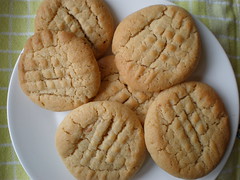(Oops, quick edit: the references on erythritol toxicity – or rather lack thereof – are now actually included…)
Crowds, Crass Commercialism, and Crappy Christmas Choruses give me a nasty case of Yule Poisoning, and I’m sure I’m not the only one.
I spent the afternoon/evening prepping for and performing some cookie experiments again, and I feel much better. Yes, my cookies are that good.
 I had a request for Peanut Butter cookies, so I figured I’d do some experimenting with that tonight. In fact, while I was braving the Christmas Consumption Crowds to get my supplies, I happened upon an ingredient that I decided I had to try as a variant.
I had a request for Peanut Butter cookies, so I figured I’d do some experimenting with that tonight. In fact, while I was braving the Christmas Consumption Crowds to get my supplies, I happened upon an ingredient that I decided I had to try as a variant.
(The picture, incidentally, is someone ELSE’S peanut butter cookies – “diekatrin” on Flickr – click photo to go to the Flickr page – I still haven’t quite gotten the hang of getting decent photos of my own food yet.)
My initial peanut-butter cookie recipe came out too dry and not sweet enough, but I think adding 50-75g of honey should solve that. That’s not the most successful experiment of the evening though. That’s reserved for the following recipe for…Sunflowerseedbutter cookies.
(Suitably pompous name pending, as soon as I test version 2.0 of the recipe, which will substitute bread flour for the “all-purpose” flour)
(Pompous Name Pending) Sunflowerseedbutter Cookies
Materials and Methods
Powdery stuff
- 190g “All Purpose”(Around 1 cup) “All Purpose” Flour
- 3g NaHCO3 (1/2 tsp)
- 1-1.5g (1/4 tsp) “Baking Powder”
- 2g (1/4tsp) NaCl
- 750mg Xanthomonas campestris exopolysaccharide (~1/4 tsp “Xanthan Gum”)
“Wet” stuff and sugars:
- 150g honey
- 100g Erythritol
- 4g glycerol (about 5ml)
- 50ml double-strength black tea
- 140g Sunflower Seed Butter (about 1/2c)
- 60g unsalted butter
- Contents of 1 Gallus gallus egg, 50-55g (approx 60g with shell… aka “large”)
- 5ml Vanilla Extract
The “dry” goods were mixed in one container, while in a separate container, the “wet” goods and the sugars were mixed in another. The dry material was then blended carefully into the wet material in a large steel mixing bowl using an electric hand-held mixer until completely homogenized.
Once homogenized, the dough was spread out in the bowl and chilled at ~18°C(O°F) for approximately five minutes to enhance firmness.
The dough was then measured onto a “non-stick” baking sheet in approximately 30ml roughly-hemispherical aliquots using a small disher, and then pressed down with a fork to approximately half their original height. A few shelled, roasted sunflower seeds were pressed into the surface of each to make distinguishing them from peanutbutter cookies easier.
The cookies were than baked at 190°C (~375°F) for approximately 18 minutes, then slid onto a “non-stick” wire cooling rack at Standard Temperature and Pressure until equilibrated with the temperature of the kitchen.
Results:
The experimenter believes this batch of cookies emerged a bit too soft – actually sliding them off of the baking sheet to the rack distorted them, and they still appeared (in the words of the experimenter) “squishy”. Once equilibrated with room temperature, the cookies had a texture more in line with what would be expected from a normal “soft cookie”. The flavor was judged to be superb by the experimenter, who happens to like the flavor of sunflower seeds.
Discussion:
The use of erythritol makes this a “reduced calorie” and “reduced-sugar” recipe, though not entirely sugarless or “diabetic safe” necessarily, due to the use of honey. Erythritol is a sugar alcohol like sorbitol, mannitol, xylitol, or glycerol (“glycerine”), all of which are often used as low-glycemic substitutes for sucrose or other sugars. Sugar alcohols can often cause digestive discomfort, however, because they are poorly absorbed by human digestive tracts, leaving them to be digested by gas-producing gut microbes. Erythritol is unique in that it appears to be well-absorbed by humans, and yet is not metabolized by humans to any substantial degree and is safely filtered out by the kidneys and excreted in urine[1]. Being unmetabilized by humans, it is theoretically “zero calorie”, though the US FDA mandates a calculation of 0.2 calories per gram (compare to 4 calories per gram for sucrose). Unlike xylitol, erythritol is also safe for dogs[2] and ferrets[Sorry, can’t find the citation for this one at the moment…], for whom xylitol can induce fatal insulin shock and/or liver damage. Erythritol, unlike glycerol or sucrose (“table sugar”), is not appreciably hygroscopic, though, so adjustments must be made to recipes using it to avoid an overly dry result.
Glycerol (sold as “Glycerine”, which can be found in cake-making supplies as an ingredient used to keep cake frosting moist) closely resembles erythritol in structure, being (to oversimplify) a one-carbon-shorter version of the same molecule. In addition to hopefully helping to prevent drying out of the cookies, this was included here in the hopes that it would also help the erythritol dissolve. Previous informal testing (unpublished results) appears to support this hypothesis.
Honey was used as a second sweetener so as to include a “real” sugar and to help counter-balance the lack of hygroscopicity of the erythritol. The experimenter also notes that he believes mixing sweeteners tends to provide a better-tasting sweetness than relying entirely on one sweetener, particularly when including less sweet “sugar substitutes” in the mix. Honey was also chosen to provide additional moisture, as a previous batch of peanut-butter cookies (the recipe from which this recipe for sunflower-seed butter is derived) using ordinary sugar and “brown sugar” had turned out excessively dry.
“Xanthan gum” is a polysaccharide (as are cornstarch and pectin, for example) produced by a natural fermentation process from the γ-Proteobacterium Xanthomonas campestris. Along with a wide variety of exotic industrial uses (such as oil-well drilling “mud”), Xanthan gum is also used as a safe food ingredient to help hold water and keep soft foods from being too runny. It helps protect ice-cream from becoming grainy during possibly partial thaw-and-refreeze cycles during shipping and storage. It’s also used to hold “gluten-free” doughs together, which is nice for people who may be allergic to gluten proteins but who still would like to eat bread…
As far as the potentially excessive softness of the cookie, the experimenter believes that substituting bread flour for “all-purpose” flour and baking for up to 20 minutes should solve the softness problem, resulting in a chewier texture which the experimenter believes will be more appropriate.
The experimenter also notes that a second batch of the same recipe, cooked for approximately 20 minutes at ~205°C (~400°F) were nearly burned, though they did come out firmer but drier in texture. The flavor was still judged superb, other than the slight burnt note. Subsequent versions of this recipe will revert back to the original 190°C cooking temperature.
Obviously, further research is needed to determine the correct modifications to achieve perfect texture, and of course, to broaden the sample size of of the taste-testing group, and the experimenter should be given a sizable grant and a nobel prize for this research. Well, a grant at least.
Or at least some praise or something. Or a cookie, except that the experimenter obviously already has some.
[1] Munro IC, Berndt WO, Borzelleca JF, Flamm G, Lynch BS, Kennepohl E, Bär EA, Modderman J:”Erythritol: an interpretive summary of biochemical, metabolic, toxicological and clinical data.”;Food Chem Toxicol. 1998 Dec;36(12):1139-74.
[2]Dean I, Jackson F, Greenough RJ:”Chronic (1-year) oral toxicity study of erythritol in dogs.”;Regul Toxicol Pharmacol. 1996 Oct;24(2 Pt 2):S254-60.
Dangit, I’m out of time. I was going to try out some crazy ideas with my Ginger Cookie recipe, too, and see if I can develop a Kombucha culture from scratch. Guess that’ll have to wait, because it’s bedtime now. Back to work in the morning…
 I’ve been talking about it for months, now I’ve finally done it: I’m calling it “Pigsfly Pie”…and it’s awesome.
I’ve been talking about it for months, now I’ve finally done it: I’m calling it “Pigsfly Pie”…and it’s awesome.
